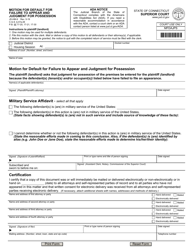This version of the form is not currently in use and is provided for reference only. Download this version of
Form JD-HM-10
for the current year.
Form JD-HM-10 Motion for Default for Failure to Plead and Judgment for Possession - Connecticut
What Is Form JD-HM-10?
This is a legal form that was released by the Connecticut Superior Court - a government authority operating within Connecticut. As of today, no separate filing guidelines for the form are provided by the issuing department.
FAQ
Q: What is a JD-HM-10?
A: JD-HM-10 is a form used in Connecticut for filing a Motion for Default for Failure to Plead and Judgment for Possession.
Q: When is a JD-HM-10 form used?
A: JD-HM-10 form is used when the defendant in a court case fails to respond to a complaint or plead within the required time period.
Q: What does the JD-HM-10 form request?
A: The JD-HM-10 form requests the court to enter a default judgment against the defendant and grant possession of the property to the plaintiff.
Q: What should I do after filling out the JD-HM-10 form?
A: After filling out the JD-HM-10 form, you should file it with the court clerk and serve a copy to the defendant.
Q: Is there a filing fee for the JD-HM-10 form?
A: Yes, there is usually a filing fee associated with filing the JD-HM-10 form. The amount may vary depending on the court.
Q: What happens after the JD-HM-10 form is filed?
A: After the JD-HM-10 form is filed, the court will review the motion and may schedule a hearing if necessary.
Q: What is the purpose of a default judgment?
A: The purpose of a default judgment is to provide a remedy for the plaintiff when the defendant fails to respond to a legal claim.
Q: Can a default judgment be contested?
A: Yes, a default judgment can be contested, but specific procedures must be followed to do so.
Q: What is a judgment for possession?
A: A judgment for possession is a court order that grants the plaintiff the legal right to take possession of the property from the defendant.
Form Details:
- Released on May 1, 2016;
- The latest edition provided by the Connecticut Superior Court;
- Easy to use and ready to print;
- Quick to customize;
- Compatible with most PDF-viewing applications;
- Fill out the form in our online filing application.
Download a fillable version of Form JD-HM-10 by clicking the link below or browse more documents and templates provided by the Connecticut Superior Court.


















